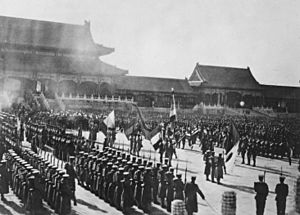Century of humiliation facts for kids
Quick facts for kids Century of humiliation |
|||||||||||||||
|---|---|---|---|---|---|---|---|---|---|---|---|---|---|---|---|
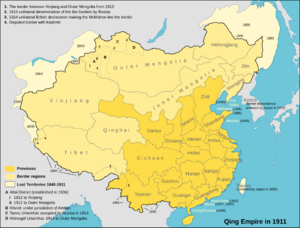
Territorial losses of the late Qing dynasty due to annexations by foreign powers
|
|||||||||||||||
| Traditional Chinese | 百年國恥 | ||||||||||||||
| Simplified Chinese | 百年国耻 | ||||||||||||||
| Literal meaning | 100 years of national humiliation | ||||||||||||||
|
|||||||||||||||
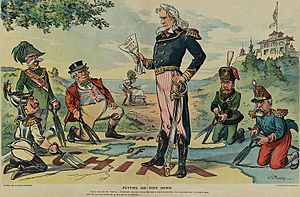
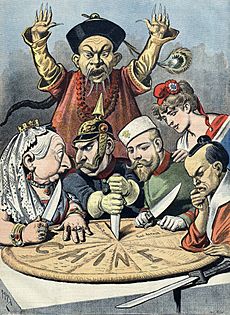
The century of humiliation (Chinese: 百年国耻, lit. hundred years of national disgrace) was a period in Chinese history beginning with the First Opium War (1839–1842), and ending in 1945 with China (then the Republic of China) emerging out of the Second World War as one of the Big Four and established as a permanent member of the United Nations Security Council, or alternately, ending in 1949 with the founding of the People's Republic of China. The century-long period is typified by the decline, defeat and political fragmentation of the Qing dynasty and the subsequent Republic of China, which led to demoralizing foreign intervention, annexation and subjugation of China by Western powers, Russia, and Japan.
The characterization of the period as a "humiliation" arose with an atmosphere of Chinese nationalism in opposition to the Twenty-One Demands made by the Japanese government in 1915, and grew further with protests against China's poor treatment in the Treaty of Versailles in 1919. Both the Kuomintang and Chinese Communist Party popularized the characterization in the 1920s, protesting the unequal treaties and loss of Chinese territory to foreign colonies. During the 1930s and 1940s, the term became common due to the Japanese invasion of China proper. Although formal treaty provisions were ended, the epoch remains central to concepts of Chinese nationalism, and the term is widely used in both political rhetoric and popular culture.
History

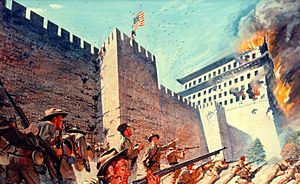
Chinese nationalists in the 1920s and the 1930s dated the Century of Humiliation to the mid-19th century, on the eve of the First Opium War amidst the dramatic political unraveling of Qing China that followed.
Defeats by foreign powers cited as part of the Century of Humiliation include the following:
- Western and Japanese trade in opium to China (1800s–1940s)
- Defeat in the First Opium War (1839–1842) by the British and the occupation of Hong Kong.
- The unequal treaties (in particular, Nanjing, Whampoa, Aigun, and Shimonoseki)
- Defeat in the Second Opium War (1856–1860) and the sacking and looting of the Old Summer Palace by Anglo-French forces.
- The signing of the "unequal treaties" of Aigun (1858) and Peking (1860) during the Second Opium War, which ceded Outer Manchuria to Russia.
- The partial defeat during the Sino-French War (1884–1885), which resulted in losing suzerainty over Vietnam and influence in the Indochinese Peninsula.
- The British Sikkim expedition (1888).
- Defeat in the First Sino-Japanese War (1894–1895) by Japan, which resulted in the Japanese colonization of Taiwan and suzerainty over Korea.
- The Pavlov Agreement that led to the Russian occupation of Liaodong (1898).
- The Eight-Nation Alliance invasion to suppress the Boxer uprising (1899–1901) and the resulting Boxer Protocol which imposed reparations in excess of the government's annual tax revenue.
- The simultaneous Russian invasion of Manchuria (1900), which resulted in anti-Chinese pogroms and the subsequent expulsion or killing of all Qing subjects in the Sixty-Four Villages East of the River.
- The Japanese invasion of Liaodong during the Russo-Japanese War (1905).
- The British expedition to Tibet (1903–1904)
- The Twenty-One Demands (1915) by Japan, which would have greatly extended Japanese control of China.
- The Treaty of Versailles (1919) in which German territory in China was handed to Japan and led to the anti-imperialist May Fourth Movement.
- The Japanese invasion of Manchuria (1931–1932)
- The Soviet invasion of Xinjiang (January– April 1934)
- The Second Sino-Japanese War (1937–1945).
In that period, China suffered major internal fragmentation, lost almost all of the wars that it fought, and was often forced to give major concessions to the great powers in unequal treaties. In many cases, China was forced to pay large amounts of reparations, open up ports for trade, lease or cede territories (such as Outer Manchuria, parts of Manchuria (Northwest China) and Sakhalin to the Russian Empire, Jiaozhou Bay to the German Empire, Hong Kong and Weihai to the British Empire, Macau to the Portuguese Empire, Zhanjiang to France, and Taiwan and Dalian to Japan), and make various other concessions of sovereignty to foreign "spheres of influence" after military defeats.
End of humiliation
Already during the conclusion of the Boxer Protocol in 1901, some of the Western powers believed they had acted in excess and that the Protocol was too humiliating. As a result, U.S. Secretary of State John Hay formulated the Open Door Policy, which prevented the colonial powers from directly carving up China into de jure colonies, and guaranteed universal trade access to markets in China. Intended to weaken Germany, Japan, and Russia, it was only somewhat enforced and was gradually broken by the following warlord era and Japanese interventions. The semi-contradictory nature of the Open Door policy was noted early, as although it preserved the territorial integrity of China from foreign powers, it also led to trade exploitation by the same countries. With the Root–Takahira Agreement in 1908, the U.S. and Japan upheld the Open Door Policy, but other factors (such as immigration restrictions, and the assignment of the Boxer Indemnity to a managed Boxer Indemnity Scholarship instead of being directly returned to the Qing government) led to a continuation in humiliation from the Chinese perspective. In the Republic of China mainland era, the 1922 Nine-Power Treaty was also a major attempt to reaffirm Chinese sovereignty, though it failed to check Japan's expansionism and had a limited effect on extraterritoriality. Open Door was ultimately dissolved in WWII when Japan invaded China.
Extraterritorial jurisdiction and other privileges were abandoned by the United Kingdom and the United States in 1943. During World War II, Vichy France retained control over French concessions in China but was coerced into handing them over to the collaborationist Wang Jingwei regime. The postwar Sino-French Accord of February 1946 affirmed Chinese sovereignty over the concessions.
Chiang Kai-shek declared the end of the Century of Humiliation in 1943 with the abrogation of all the unequal treaties and Mao Zedong declared its end in the aftermath of World War II, with Chiang promoting his wartime resistance to Japanese rule and China's place among the Big Four in the victorious Allies in 1945, and Mao declared it with the establishment of the People's Republic of China in 1949.
Chinese politicians and writers, however, have continued to portray later events as the true end of humiliation. Its end was declared in the repulsion of UN forces during the Korean War, the 1997 reunification with Hong Kong, the 1999 reunification with Macau, and even the hosting of the 2008 Summer Olympics in Beijing. Some Chinese nationalists claim that humiliation will not end until the People's Republic of China controls Taiwan.
In 2021, coinciding with the United States–China talks in Alaska, the Chinese government began referring to the period as 120 years of humiliation, a reference to the 1901 Boxer Protocol in which the Qing were forced to pay large reparations to members of the Eight-Nation Alliance.
Implications
The usage of the Century of Humiliation in the Chinese Communist Party's historiography and modern Chinese nationalism, with its focus on the "sovereignty and integrity of [Chinese] territory," has been invoked in incidents such as the US bombing of the Chinese Belgrade embassy, the Hainan Island incident, and protests for Tibetan independence along the 2008 Beijing Olympics torch relay. Some analysts have pointed to its use in deflecting foreign criticism of human rights abuses in China and domestic attention from issues of corruption and bolstering its territorial claims and general economic and political rise.
Similar usage
In a 2019 speech, Indian Minister of External Affairs S. Jaishankar used the term in a local context, referring to the British Empire's Company rule in India and subsequent British Raj, saying, "India had two centuries of humiliation by the West."
See also
- Anti-Japanese sentiment in China
- Anti-Western sentiment in China
- Chinese Century
- Chinese concession of Incheon
- Foreign concessions in China
- Hurting the feelings of the Chinese people
- List of Chinese treaty ports
- List of treaties of China (1689-1949)
- Revanchism
- Scramble for China
- Sick man of Asia
- Territorial losses of Thailand
- Unequal treaties
- Western imperialism in Asia


